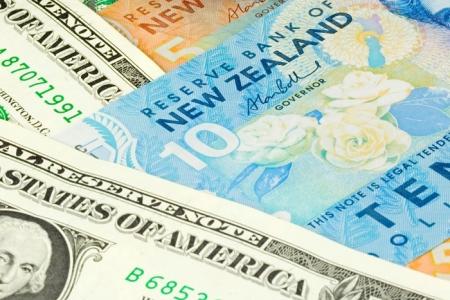
Daily Market Analysis and Forex News
Week Ahead: 3 reasons to watch NZDUSD

The New Zealand dollar (NZD) is the second worst-performing G10 currency against the US dollar so far this month, with NZDUSD having fallen by about 3.4% month-to-date.

But before we get into the reasons that could either worsen or offer relief to NZDUSD's woes, let’s first look at the list of key economic data releases and events that could move FX markets next week:
Monday, February 20
- CNH: China loan prime rates
- EUR: Eurozone February consumer confidence
- US markets closed
Tuesday, February 21
- AUD: Reserve Bank of Australia policy meeting minutes
- EUR: Eurozone February ZEW survey, PMIs
- GBP: UK February PMIs
- CAD: Canada January inflation, December retail sales
- USD: US February PMIs
Wednesday, February 22
- NZD: RBNZ rate decision, January external trade
- EUR: Germany January CPI (final)
- USD: FOMC minutes
Thursday, February 23
- EUR: Eurozone January CPI (final)
- USD: US weekly jobless claims, Q4 GDP (second), Atlanta Fed President Raphael Bostic speech
Friday, February 24
- JPY: Japan January CPI; BOJ Governor-nominee Ueda to appear before Japan’s lower house
- EUR: Germany Q4 GDP (final), March consumer confidence
- USD: US January PCE deflator, personal income and spending, February consumer sentiment
- 1-year anniversary of Russia’s invasion of Ukraine
Now, here are 3 reasons why we’re watching NZDUSD:
#1: Reserve Bank of New Zealand (RBNZ) rate decision
New Zealand’s central bank is expected to hike by another 50 basis points next week to bring its Official Cash Rate up to 4.75%.
But the RBNZ may be faced with a dilemma:
- On one hand, policymakers may be forced to keep hiking to offset any near-term inflationary pressures stemming from supply chains that have been disrupted by Cyclone Gabrielle (think of destroyed fruit and vegetable farms, which in turn drive up prices of harder-to-find food supplies).
- On the other hand, the RBNZ may opt for the relatively smaller 25-bps hike instead because of the deadly cyclone’s negative impact on New Zealand’s economy.
(Note that interest rate hikes are intended to “destroy” demand to subdue inflation.
But if some of that demand has already been destroyed by Cyclone Gabrielle, more rate hikes risks sending New Zealand into a recession!)
Hence, amid this dilemma, NZDUSD could be rocked by:
- the size the RBNZ’s incoming rate hike
- and what the central bank says about its future plans for the official cash rate.
As a rule of thumb, the central bank that can continue sending its benchmark rates higher than its peers, should see its currency strengthen.
And as things stand, markets are now forecasting that the RBNZ’s official cash rate will peak around 5.2% in May this year.
If the RBNZ has to ease up on its rate hikes and stop short of that 5.2% forecasted peak, that may spell more near-term declines for NZDUSD, and vice versa.
But just as markets digest the results of Wednesday morning’s RBNZ meeting, attentions will quickly shift to the US Dollar side of the NZDUSD equation for the rest of the week.
And that brings us to our second reason ...
#2: More clues about incoming Fed rate hikes
Arguably, the single biggest driver across FX markets has been the shifting expectations surrounding the Fed rate hikes.
The US dollar could extend its February recovery if any (or a combo) of the scenarios below materialize:
- Minutes from the FOMC’s Jan 31-Feb 1 meeting suggest US policymakers are still wary about the inflation outlook, despite opting to hike by “only” 25 basis points (bps) earlier this month. (25bps is much smaller than the 75bps hikes triggered multiple times around mid-2022)
- US weekly initial jobless claims remain around historically-low levels around 200k, which underscores the strength of the US jobs market.
- Atlanta Fed President Raphael Bostic’s speech heralds even more Fed rate hikes (though Bostic is a non-voting member of the FOMC this year)
- The US PCE Deflator, the Fed’s preferred way for measuring inflation, comes in higher than the 4.9% advance expected for January. That’s only slightly lower than December’s 5% year-on-year rise, suggesting that inflation still isn’t abating fast enough despite the Fed’s rate hikes totalling 450 bps already since Q1 2022.
Overall, if US hiring and inflation remain resilient while reinforcing the Fed’s hawkish chorus, that could strengthen the US dollar while heaping more downward pressure on NZDUSD.
And that brings us our final stated reason for this article …
#3: NZD is forecasted to be second-most volatile G10 currency next week
Noting the uncertainty surrounding the RBNZ and Fed’s respective rate-hiking plans, no surprise that NZDUSD is expected to rather volatile over the coming week.
(The G10 currency that’s expected to be most volatile - the Norwegian Krone - is highly sensitive to commodity prices and broader risk sentiment).

While it remains to be seen whether the implied volatility actually becomes reality, make no mistake: NZD traders are ready to pounce on fresh signals emanating out of the RBNZ or surrounding the Fed next week.
Key levels for NZDUSD in the week ahead:
SUPPORT
- 0.620 region: this psychologically-important area has supported NZDUSD on several occasions since May/June 2022, and most recently in January 2023. This is also around where this FX pair’s 200-day simple moving average currently lies
- 100-day simple moving average (SMA)
- 0.61462: 61.8% Fibonacci level from NZDUSD’s October 2022-February 2023 ascent.
RESISTANCE
- 0.62702: February 6th cycle low
- 0.63186: 78.6% Fibonacci level from NZDUSD’s October 2022-February 2023 ascent.
- 50-day SMA

At the time of writing, Bloomberg’s FX model forecasts a 71% chance that NZDUSD will trade within the 0.6085 – 0.6344 range, using current levels as a base, over the next one week.
Ready to trade with real money?
Open accountChoose your account
Start trading with a leading broker that gives you more.